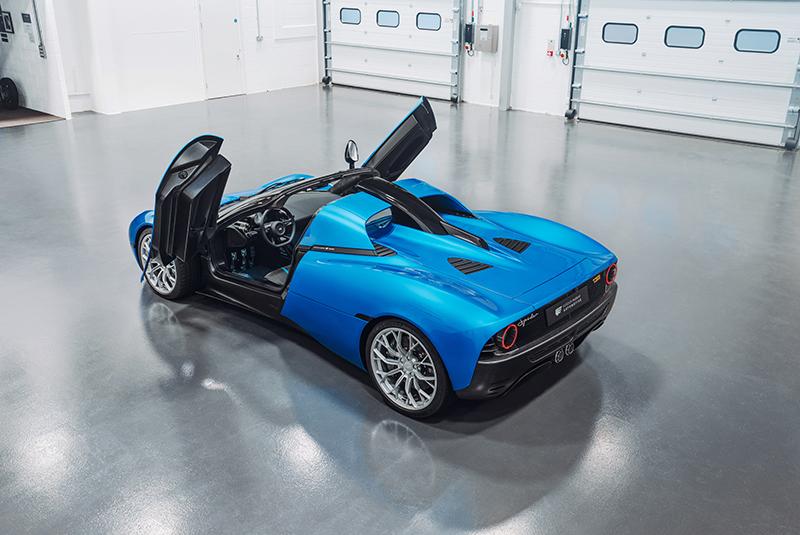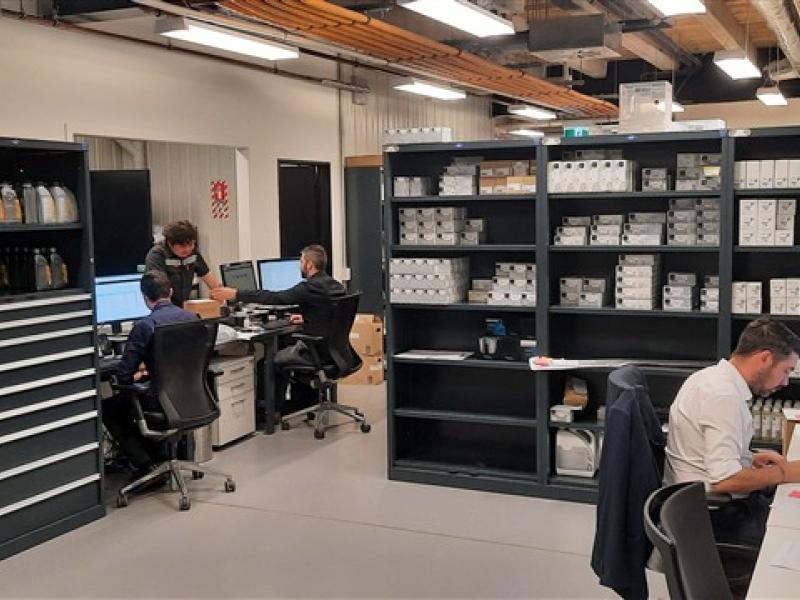The T.33 Spider from Gordon Murray Automotive combines the beautiful, timeless design of the T.33 with an even more immersive and engaging driving experience. With two removable roof panels, a deployable rear window and the naturally-aspirated Cosworth GMA.2 V12 behind the cabin, there is no other supercar like it.
Developed in parallel with the T.33 and sharing the same Ultralight carbon fibre monocoque construction, the T.33 Spider has been meticulously engineered to deliver the exceptional torsional stiffness needed for outstanding ride, handling and agility without adding unnecessary weight. In achieving all these targets, and by adhering to GMA’s seven core principles, the T.33 Spider sets a new benchmark for open supercars.
Professor Gordon Murray CBE said, “When drawing a car, I imagine what it’s going to feel like to sit in, and how it will feel to drive. So, from the first sketch I knew that, with its open cockpit and the incredible Cosworth GMA.2 V12 engine right behind you, the T.33 Spider would deliver a truly involving driving experience that’s quite unlike anything else. And while it’s still a mid-engine supercar I wouldn’t accept any compromise on usability: this is why the T.33 Spider is unique in the supercar sector in delivering both onboard roof storage and a 295-litre luggage capacity.”
Exterior design
Spider: an evocative name perfectly suited to the breath-taking, timeless T.33.
Gordon Murray said “From the very beginning I knew that one of the biggest challenges in designing the T.33 Spider would be keeping the purity, balance and overall beauty of the T.33. That’s why I sketched both versions at the same time to make sure that the proportions would work.”
Interior design
Simple, elegant, analogue: the T.33’s interior embodies these defining qualities and delivers a truly driver-focused environment. Befitting a supercar, the focal point of the instrument cluster is the 120mm, floodlit and defiantly analogue centrally-mounted rev counter. Calibrated to 11,100 rpm it clearly signals the Cosworth GMA V12’s performance potential.
All of the main controls are beautifully tactile, with the carbon fibre steering wheel trimmed in leather and the perfectly-weighted pedals, gear shift lever and switchgear machined from aluminium alloy. The lightweight, race-inspired carbon fibre seats are trimmed in a combination of leather and Alcantara. As part of the customer experience, each car is perfectly tailored to its owner.
Aerodynamics
Leveraging all the experience accrued from a career designing ground-effect racing cars, Gordon Murray and his team developed the T.33 Spider’s exceptional aerodynamics without resorting to the ostentatious ducts, skirts and splitters that are typically used in other supercars. Such devices would compromise the timeless design so instead, first principles were used to develop the T.33 Spider’s Passive Boundary Layer Control (PBLC) system. Introduced on T.33, PBLC has been further refined for the Spider. A ground-effect inlet at the front of the car directs low pressure air underneath the floor, which is then fed into a rear diffuser with a boundary layer removal duct. In combination with the deployable active rear spoiler, PBLC delivers the ideal balance of low drag, high-downforce and superb high-speed stability, with or without the roof panels in place.
The fixed rear section of the roof, which provides rollover protection, is an integral part of the body design to optimise stiffness while delivering the design vision. Its form is carefully optimised to minimise drag and buffeting when the panels are not fitted, this faired-in design being more streamlined than the twin ‘humps’ behind the seats that are typical of a speedster body style.
Body structure
The T.33 Spider is shaped around Gordon Murray Technologies’ iStream Ultralight carbon monocoque technology.
Comprising carbon fibre composite panels bonded to extruded aluminium tubing triangulated at precision die-cast aluminium nodes, this delivers a body structure which provides the optimal balance of high stiffness, light weight, and exceptional levels of safety and occupant protection.
Developed in parallel with the coupe, the T.33 programme was Spider-led, which meant that all torsional rigidity targets were set for the Spider body structure. This ensured no compromises to structural integrity and avoided the weight increases which typically arise from the traditional approach of adding reinforcements and bracing.
As a result, and a consequence of GMA’s obsessive focus on weight reduction – down to single grams from every component – the T.33 Spider has a target dry weight of 1,108 kg, just 18 kg more than the coupe, and will deliver the same superlative driving experience.
Chassis and Suspension
As befits two cars designed and developed in parallel, the T.33 Spider is engineered to meet the same demanding targets for ride, handling and steering as the T.33. The inherently light, stiff, composite body structure delivers the ideal starting point for world-class vehicle dynamics, thanks to its outstanding torsional rigidity and local stiffness around the chassis mounting points. Like the coupe, T.33 Spider features all-round double wishbone suspension, made from lightweight aluminium. The high pressure monotube dampers are of coilover design and are also made from aluminium. GMA’s vehicle dynamics team have purposefully chosen not to offer adaptive damping.
Following motorsport practice, the powertrain of the T.33 Spider is semi-structural, with the rear suspension mounted directly to the transmission casing. To maximise the weight reduction and vehicle dynamics benefits this brings without undue noise, vibration and harshness being transmitted into the cabin, the system features GMA’s Inclined Axis Shear Mounting (IASM). The IASM system uses flexible mountings to deliver exactly the right amount of isolation required for refinement while at the same time enabling precise handling.
To ensure that the T.33 Spider responds directly to every input the driver makes at the wheel, no matter how small, GMA has developed an electrohydraulic steering system. Honed over countless iterations to deliver unrivalled levels of feel, weight and feedback, it uses an on-demand electric pump to provide the power assistance. This system delivers the purity of traditional hydraulic steering but with greater energy efficiency due to the removal of the parasitic losses from an engine-driven pump.
Ensuring the delivery of fade-resistant deceleration under all driving conditions, a Carbon Ceramic Matrix (CCM) braking system has been developed specifically for T.33 and T.33 Spider. Delivering an ideal combination of high thermal resistance, low unsprung mass and reduced wear, it features 370 mm x 34 mm discs and six-piston monobloc calipers on the front axle and 340 mm x 34 mm discs with four-piston monobloc calipers at the rear. In combination with the downforce provided by the car’s cutting-edge aerodynamics, the CCM brakes deliver stopping power commensurate with the Cosworth GMA.2 V12’s exceptional performance.
To deliver the traction and steering response demanded from the rear-wheel drive configuration, together with the minimum possible mass, the T.33 Spider, like the coupe, uses an asymmetric wheel and tyre specification. The front and rear axles feature lightweight, forged aluminium 19-inch and 20-inch wheels respectively, together with 235/35 ZR19 and 295/30 ZR20 Michelin Pilot Sport 4 S tyres.
Engine and Transmission
Just like its coupe stablemate, the heart of the T.33 Spider is the exemplary Cosworth GMA.2 V12. This extraordinary all-aluminium powerplant is designed according to motorsport principles in partnership with Cosworth to deliver GMA’s exacting brief: lightest, highest specific output, highest revving, fastest response.
Addressing the fundamentals of high-performance engine design, the dry-sump, 3.9-litre unit features a 65-degree cylinder bank angle for optimum packaging within the monocoque, and contributing to the car’s low centre of gravity. Obsessively weight-optimised, the exquisite exhaust manifolds are crafted from inconel – lightweight and capable of withstanding extremes of temperature.
Foregoing turbocharging for the compromises this imposes in throttle response and to aural quality, the GMA.2 is naturally-aspirated, fed via the ram air scoop and four throttle bodies, together with two fuel injectors per cylinder. Together with the inherently low inertia afforded by the use of titanium for critical components such as the connecting rods, this combination delivers unrivalled responsiveness: 75 per cent of the 451 Nm maximum rated torque is available from only 2,500 rpm, while 90 per cent is maintained from 4,500-10,500 rpm. Maximum power of 617 PS is delivered at 10,250 rpm, with the engine electronically-limited to an astonishing 11,100 rpm, at which point the driver is rewarded with an unmistakable 12-cylinder crescendo before shifting to the next gear. The complete engine weighs just 178 kg: this is the world’s lightest road car V12 engine.
In response to overwhelming customer demand for the manual gearbox on the T.33 coupe, the Spider is offered exclusively with this transmission. Developed with world-renowned motorsport supplier Xtrac, this six-speed unit – like the V12 it is matched to – is designed to be as mass-efficient as possible. At only 82 kg, there is no lighter supercar transmission, and it delivers the quick, smooth, precision shifts that enthusiasts demand and expect.
The powertrain is completed by a multi-plate clutch which delivers the required torque capacity with minimal inertia, and a mechanical limited-slip differential. Compared with electronically-controlled units, this design ensures that the driver has ultimate control over the vehicle’s responses and handling balance at all times.






